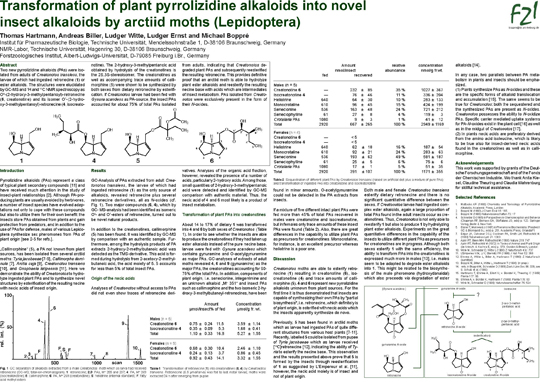Insekten-PA und Pheromon-Biosynthese
Von Pflanzen aufgenommene PA werden von Arctiinae zum Teil in so genannte Insekten-PA und Balzpheromone umgewandelt.
Edgar JA, Boppré M, Kaufmann E. Why do insects modify plant-derived pyrrolizidine ester alkaloids? Manuscript
Edgar JA, Boppré M, Kaufmann E (2007) Insect-synthesised retronecine ester alkaloids: precursors of the common arctiine (Lepidoptera) pheromone hydroxydanaidal. J Chem Ecol: 33:2266-2280 link
Many pyrrolizidine alkaloid (PA)-adapted insects convert PAs sequestered from their larval host plants, into "insect-PAs" in which the acid components of the alkaloids are replaced by small, branched aliphatic 2-hydroxy acids of insect origin. It has been proposed that insect-PAs are precursors of the pheromone hydroxydanaidal in male Estigmene acrea moths but it is not clear why they are specifically required or what are the structural features or chemical properties that make insect-PAs more suitable for conversion into hydroxydanaidal than superficially similar alkaloids of plant origin. Evidence is presented here that insect-PAs are also precursors of hydroxydanaidal in the polyphageous arctiine Creatonotos transiens and a new biosynthetic pathway to hydroxydanaidal is proposed that has a mandatory requirement for insect-PAs as intermediates.
Many pyrrolizidine alkaloid (PA)-adapted insects convert PAs sequestered from their larval host plants, into "insect-PAs" in which the acid components of the alkaloids are replaced by small, branched aliphatic 2-hydroxy acids of insect origin. It has been proposed that insect-PAs are precursors of the pheromone hydroxydanaidal in male Estigmene acrea moths but it is not clear why they are specifically required or what are the structural features or chemical properties that make insect-PAs more suitable for conversion into hydroxydanaidal than superficially similar alkaloids of plant origin. Evidence is presented here that insect-PAs are also precursors of hydroxydanaidal in the polyphageous arctiine Creatonotos transiens and a new biosynthetic pathway to hydroxydanaidal is proposed that has a mandatory requirement for insect-PAs as intermediates.
Schulz S, Beccaloni G, Brown KS, Boppré M, Freitas AVL, Ockenfels P, Trigo JR (2004) Semiochemicals derived from pyrrolizidine alkaloids in male ithomiine butterflies (Lepidoptera: Nymphalidae). Biochem System Ecol 32: 699-713. lesen / read
Analysis of male hairpencil components of 28 genera and 46 species of Ithomiinae butterflies showed the presence of 13 volatile compounds formed by hydrolysis, oxidation, lactonization and/or methylation of both necic acid and pyrrolizidine base portions of lycopsamine, an alkaloid widespread in nature and known to be specifically sought, ingested and stored by these insects. Six of these compoundshave not been reported before from insects. Comparison of occurrence patterns with proposed phylogenies of the 50 or more genera in the subfamily did not give clear patterns, though simpler derivatives well known in other Lepidoptera occurred throughout the subfamily, while more specific structures, including a lactone resulting from specific oxidation of an unactivated methyl group, were more typical of apomorphic genera.
Schulz S, Francke W, Boppré M, Eisner T, Meinwald J (1993) Insect pheromone biosynthesis: stereochemical pathway of hydroxydanaidal production from alkaloidal precursors in Creatonotos transiens (Lepidoptera, Arctiidae). Proc Natl Acad Sci USA 90: 6834-6838. lesen / read
The mechanism by which the moth Creatonotos transiens produces its male pheromone, (7R)-hydroxydanaidal, from heliotrine, an alkaloidal precursor of opposite (7S) stereochemistry, was investigated. Specifically deuteriated samples of heliotrine and epiheliotrine were prepared and fed to C. transiens larvae, and the steps in the biosynthetic process were monitored by gas chromatography/mass spectrometry. These analyses indicate that heliotrine is initially epimerized to (7S)-epiheliotrine by oxidation to the corresponding ketone followed by stereospecific reduction. The order of the subsequent steps is (i) aromatization of the dihydropyrrole ring, (ii) ester hydrolysis, and (iii) oxidation of the resulting primary alcohol to the final aldehyde. The ecological implications of this insect's ability (and the inability of another moth, Utetheisa ornatrix ) to use representatives of two stereochemical families of alkaloids as pheromone precursors are discussed.
Hartmann T, Biller A, Witte L, Ernst L, Boppré M (1990) Transformation of plant pyrrolizidine alkaloids into novel insect alkaloids by arctiid moths (Lepidoptera). Biochem Syst Ecol 18: 549554.
Two new pyrrolizidine alkaloids (PAs) were isolated from adults of Creatonotos transiens , the larvae of which had ingested retronecine or ester alkaloids. The structures were elucidated by GC-MS and 1H and 13C NMR spectroscopy as O9-(2-hydroxy-3-methylpentanoyl)retronecine (creatonotine) and its isomer O7-(2-hydroxy-3-methylpentanoyl)retronecine (isocreatonotine). The 2-hydroxy-3-methylpentanoic acid obtained by hydrolysis of the creatonotines is the 2S,3S-stereoisomer. The creatonotines as well as accompanying trace amounts of callimorphine were shown to be synthesized by both sexes from dietary retronecine by esterification. If Creatonotos larvae had been fed with Gynura scandens as PA source, the insect PAs accounted for about 75% of total PAs isolated from adults, indicating that Creatonotos degraded plant PAs and subsequently re-esterified the resulting retronecine. This work provides definitive proof that an arctiid moth is able to hydrolyse plant ester alkaloids and re-esterify the resulting necine base with acids which are intermediates of insect metabolism. PAs isolated from Creatonotos were exclusively present in the form of their N -oxides.
Bell TW, Boppré M, Schneider D, Meinwald J (1984) Stereochemical course of pheromone biosynthesis in the arctiid moth, Creatonotos transiens . Experientia 40: 713-714. lesen / read
The biosynthetic conversion of a pyrrolizidine alkaloid (heliotrine, IV) to a male moth pheromone (hydroxydanaidal, III) is found to proceed with inversion of configuration at the remaining asymmetric center (C-7).
Schneider D, Boppré M, Schneider H, Thompson WR, Boriack CJ, Petty RL, Meinwald J (1975) A pheromone precursor and its uptake in male Danaus butterflies. J Comp Physiol 97: 245-256

